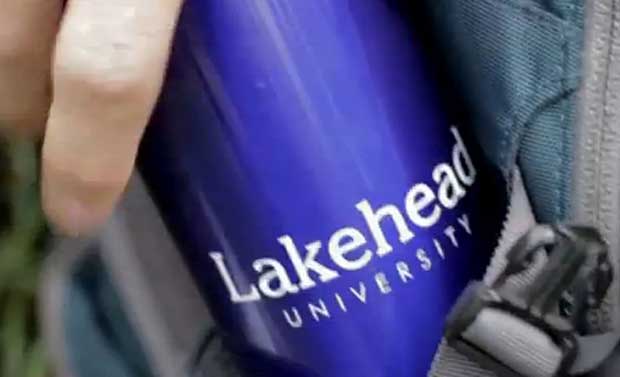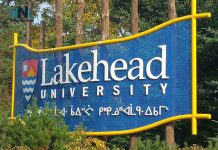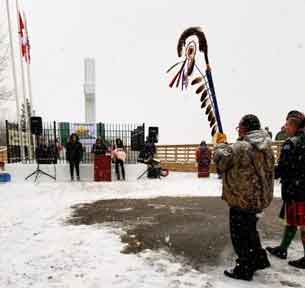 THUNDER BAY – Lakehead University was home to a full house of `over 200 people for a talk on the relationships between Aboriginal and Non-Aboriginal cultures. It was a fantastic night of leadership demonstrated by Lakehead University.
THUNDER BAY – Lakehead University was home to a full house of `over 200 people for a talk on the relationships between Aboriginal and Non-Aboriginal cultures. It was a fantastic night of leadership demonstrated by Lakehead University.
Aboriginal Issues at Lecture Series
The 2012 Ken Morrison Lecture Series event featured addresses by President Brian Stevenson (Lakehead University), Chief Peter Collins (Fort William First Nation), Mayor Keith Hobbs (City of Thunder Bay), and Wendy Landry (Chair of the City Crime Prevention Council Chair and President of the Thunder Bay Council of the Metis Nation of Ontario). Audience participation will be encouraged through a question and answer period.
The relationships between First Nations and the rest of society is one that many in Thunder Bay and across Northern Ontario are developing, and needing to evolve to one of mutual respect.
Mayor Hobbs shared some of his history. When he was ten years old, Mayor Hobbs was the victim of a bullying incident and was injured by the bully who called him an ‘Indian lover’. “Racism in Thunder Bay has been an issue for years, and is one that has to “come to the table,” said Mayor Hobbs.
Hobbs stated, “Communities across the North do not have the very ammenities that we here in the city of Thunder Bay take for granted. Safe drinking water, indoor plumbing, are not experienced in many of the First nations communities”.
Hobbs said, many people coming from the North suffer from issues with addiction, a lack of education, and racism.
Hobbs referred to a letter published in the newspaper blaming him for all the crime in the city because he “invited all those people from the North” to Thunder Bay. Hobbs challenged the audience to take on those issues head on.
Hobbs stated that those kinds of letters and attitudes disgust him.
Hobbs commented that his goal with the help of young people will be to make Thunder Bay a better place to live for everyone.
Thunder Bay Superior North MP Bruce Hyer introduced Dr. Brian Stevenson to the audience. Hyer said, “If First Nations people do well, all Northwestern Ontario will do well”.
Hyer shared a program that was created in Winnipeg where young Aboriginal students, in earlier grades are in effect paid for good grades.
Dr. Brian Stevenson, the President of Lakehead University said “For those who remember Phil Donahue, that is how I am going to lecture”.
“All our voyages are personal. I grew up as a child, interested in indigeounes people,” commented Stevenson. “If you are going to have development, you are going to have to have development with identity,” stated Stevenson.
Since arriving at Lakehead University, Stevenson said he has engaged in a consultive proccess to engage the University as a way to protect language and culture.
Stevenson spoke of the vision of The Gichi Kendaasiwin Project, a plan to have a building at Lakehead University for the facility. “We have to dream bigger, we have to do more,” said Stevenson.
“Lakehead University is working on a living blueprint. Lakehead has set four directions for success – based on the Medicine Wheel. The building that we have talked about would include education facilities, a daycare facility and all the needed facilities”.
Currently 11% of the University population is Aboriginal. Stevenson said that only 16% of the total population go to university, but a smaller number of Aboriginal students. “We have to grow the population of Aboriginal students”.
The second factor is that there is a great flow of growth of young people coming through the system – Lloyd Axeworthy, Stevenson said called that a potentially lost generation of youth.
By the twelvth grade, Stevenson said many of the students have dropped out and are already ‘lost’ to higher education.
Stevenson said that Thunder Bay and Lakehead University is already behind many other universities as we do not have ‘a gathering place for higher learning and sharing of wisdom”.
“I would like this to be a meeting place on campus, so we can begin to over come the problems of racism”. The plan includes the Achievement Fund, which includes a Youth Outreach Program, with an outreach program.
The goal will be to sign up youth across the region, and as youth sign up, at the end of ten years, depending on how the funds are raised, and those young people will have a fund already in place, in their names to be able to attend Lakehead University.
“We are going to help you become part of the Lakehead University family,” added Stevenson.
The plan also includes an Adult Achievement fund. We want to be able to build endowment funds into helping adult students return to school.
Stevenson recognise that it will take a great deal of courage for an adult to return to school.
“If I do anything while I am here,” Stevenson said, “it will be the Nanabijou Childcare Centre”. Those young people are “my future students” said Stevenson. It will take visionary thinking, commented the President.
We are moving forward on this project via a referendum which was approved by the Student Union and students to build a new daycare centre in the next eighteen months.
We will move to the Immersive TelePresence system which will be an immersive meeting experience, that offers ultimate video and audio clarity.
It is going to take Broadband expansion and that is already happening with the province and private partners.
As well, through partnerships with Wasaya Airlines, Lakehead University has been able to send their sports teams to Northern communities. “I think Wasays Airlines and our Athletics facilty have put together a wonderful program”.
Tammy Bobyk whose traditional name is Eagle Woman. Tammy graduated in 1995 from Lakehead. She said that “It is amazing that we are actually going to have a building, when I went, we didn’t have a room”.
This past weekend the LUNSA Pow Wow was held. Tammy shared how the Pow Wow was held in the Agora. It was an effort back then to get access to the gym at the University.
Tammy said she was the first to graduate from university in her family. She is a graduate of C.D, Howe and Hammarskjold High School.
She is the Executive Director at Shkoday Abinojiiwak Obimiwedoon which runs the Biwaase’aa program.
“We take education very seriously, education is the way forward”.
“When we talk about the city and racism, it is usually negative.” She explained how an incident happened that led to a murder of one of her students, another seriously injured and paralized and another student stabbed in the neck”.
It was difficult for the students to stay in the community after that.
Building the move toward success has come in creating new programs, like Headstart.
“The best thing we can do as a community is to identify the struggles that students find coming down from Northern Communities. One of the things is culture shock, the noise and the visual stimulation in the city”.
While many of us consider those things to be completely ‘normal’, to a student coming from a small northern community they are foreign. “There are many success stories out there, and no body gets to hear them enough. The actions of people with racism, name calling and hate don’t leave you, Tammy said. They either make you or break you.”
Wendy Landry a member of the Red Rock First Nation said, “I wear so many hats, I struggled on what to talk about tonight”.
“Dr Stevenson spoke on identity, and speaking from our heart. I grew up with some turbulent years, which I now attribute to identity crisis. I knew growing up, who I was, I was indigeonus and Indian, yet the canadian government said ‘no you are not”.
“It wasn’t until 1993 that I was introduced to the Ontario Metis Nation. I grew up traditional”.
“I know who I am”.
It is only the Canadian government who can tell you who you are, you know who you are in your soul. With changes in legislation, I am now ‘Indian’, but my children are not. There is so much of Aboriginal identity that is not understood, it is key to understanding who we are”.
“We demand that the Canadian government honour the treaty rights. We have the responsibility to learn and accept each other’s culture”.
Wendy shared how history is written by the victors, but how the Aboriginal people are now helping to re-write those history books. “There is confusion in Aboriginal cultures, and we need to move forward to what Canada truly does stand for. Tolerance, patience and respect are the three keys to coming together”.
“We need to raise our children to be respectful. Be true to yourself and accepting of others, then crime prevention will happen”.
Peter Collins commented on how getting the word out, has been difficult. The traditional lands for Fort William First Nation had been surveyed and the community had been measured wrong. Going forward on the land claims has helped. “Our community was expropriated in 1905, our houses, churches and cemeteries were taken away”. That lead to animosity that had continued since. The atrocities that happened are areas which need to be settled”.
“It is a work in progress”, said Collins, “does money fix the issue? No? It softens the issue”.
Nicole McKay, the Lakehead University Native Students Association President commented “I appreciated what was shared, I wanted to say to Tammy, thank you for paving the way”. At the Pow Wow, we had many volunteers from many cultures”. Because of work that was done, young people have that opportunity”.
Thunder Bay is moving forward. Lakehead University is demonstrating great leadership in helping to build bridges and forge the way forward.
James Murray









